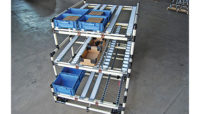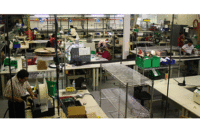Each custom-built appliance uses a different chassis, dozens of different components, and variations in processes such as cabling, branding, software image loading, and testing. These widely divergent requirements can wreak havoc on scheduling, workload distribution, on-time delivery and particularly quality control.
Several years ago, MBX addressed these issues by developing special production, picking, tracking, staffing and quality control procedures. The company also developed proprietary shop floor software tailored to the plant’s needs. Highlights include a new work center arrangement with more narrowly defined tasks, replacement of written build instructions with visual documents to facilitate correct assembly of each system, and deployment of Apple iPads to replace a picking system based on paper tickets.
Over the next year, these and other changes yielded:
- A 42 percent reduction in system and workmanship defects.
- A 57 percent increase in manufacturing volume in the same physical space.
- A 94 percent customer retention rate, up from 77 percent.
- A 116 percent jump in sales, even during the depths of the recession.
Significantly, much of that growth came from new customers dissatisfied with their previous contract manufacturers. One such customer was a digital media services company whose appliances frequently malfunctioned within hours of deployment. Another was a provider of investigation management software whose previous supplier shipped three defective boxes in a row. Those reliability problems disappeared with the switch to MBX, thanks to the strategies the plant established for maintaining quality in a high-mix environment.
Hundreds of Permutations
MBX primarily manufactures OEM hardware appliances used by software vendors as an alternative to delivering their applications to corporate data centers on CDs, as electronic downloads or in the cloud.
Each system is built to optimize the performance of that particular application and preloaded with the vendor’s software, eliminating the need for IT staff at the customer site to install, configure and fine-tune software setup. Applications include data archiving, network storage, network monitoring, data and network security, content management, voice over IP, video production and video on demand.
MBX also manufactures turnkey hardware-and-software modules to be embedded in products ranging from medical equipment to industrial machinery.
With these disparate functions and unique customer needs, no two platforms are alike. One system may be the size of a set-top box, while another may occupy a 6-foot-tall rack large enough to hold 42 servers. Some will have video capture or TV tuner cards, while others will require encryption chips, solid-state hard drives or other specialty parts in addition to motherboards, processors and memory to match the specific application.
Customers such as SnapStream, a supplier of television search and monitoring appliances, have unique requirements, such as custom testing and special configuration of each machine based on the channels the end user wants to record. Other needs such as custom scripting, special back-of-machine port labeling, specialty brackets to hold components in place, and anti-tampering features for government use, add to the challenge of consistently delivering quality product. Yet MBX is succeeding.
“Since all of our customers require 24/7 reliability, it’s mission-critical that we provide the [best performing], fault-tolerant and efficient server-class hardware. MBX not only helps us accomplish that feat, but also goes the extra mile to ensure the future success of our company,” says Adrienne Gonzalez, enterprise support specialist at SnapStream, which has reported only two defects since MBX began implementing its new manufacturing software and processes in 2009.
Divide and Conquer
As part of those operational changes, MBX divided the assembly process into more discrete tasks, doubled the number of work centers to correspond to those tasks, and imposed associated controls, such as automatically displaying build instructions on the assembler’s computer monitor as a job arrives at his workstation.
Instead of the previous three-station setup, MBX now runs six work centers. Each job begins with picking in the warehouse and then moves to preassembly, where raw components like motherboards and hard drives are installed into the chassis.
Next comes:
Cabling, which includes wiring and installation of custom-branded faceplates, color-coding of ports for easy customer connectivity, and in some cases the addition of security protections, such as blocking unused ports.
Visual inspection, to validate the accuracy of the physical assembly.
Configuration, for software installation and testing.
Final quality control inspection, to approve the physical appearance and functionality of the finished appliance.
Supporting this new arrangement is MBX’s new project management software, called Signal, and an array of other new processes specifically designed to cope with the variation in customer needs.
These include:
Customized workflow for each appliance. When each new job order comes in, platform engineers work with the customer to determine his needs, configure the system, create the bill of materials, and define the steps required to complete the build. The workflow is then entered into the production software, which makes it possible to customize job routing for each order based on the tasks that must occur in each work center and the background processes required to fulfill these tasks.
Wiki-based documentation of each platform design. Use of a wiki instead of printed design documents ensures that assemblers have access to current build information on every appliance or embedded system. Design updates based on component changes or work center feedback to manufacturing engineers can be incorporated into the wiki immediately and tracked by date, user and reason for future reference.
Replacement of text-based assembly instructions with visual documentation. As prototypes are being assembled, documentation technicians develop visual build documents that show every component location, cable turn, screw torque and other information. These documents, with accompanying written instructions, are entered into the wiki and displayed at the relevant work center on professional-grade 23-inch LCD monitors with a wide, 178-degree viewing angle that enables assemblers to view the screen from multiple positions without distortion.
Build instructions customized for each work center. As each hardware unit arrives at a workstation, the builder scans a bar code affixed to the chassis and instantly receives build instructions related exclusively to the tasks for which that station is responsible. Removing instructions that are not relevant to a particular work center saves time and eliminates confusion.
Quality Plus Efficiency
All of MBX’s processes contribute to quality assurance. For example, adding a new inspection work center midway through the line process enables assembly errors to be caught earlier in the build. In fact, every appliance or embedded system undergoes repeated inspections—not just one unit in 10 or 50.
Numerous other checkpoints and controls also help keep workmanship defects at bay.
For starters, assemblers at each work center physically check the previous station’s accuracy against the visual build document to see if there is any deviation. As a result, every appliance is inspected at least five times—once for each work center after leaving preassembly. Any anomalies are recorded and corrected by the builder before the order moves to the next workstation.
Second, if any configuration step is overlooked, MBX’s production software automatically detects the omission, posts a warning on the computer screen, and prevents the builder from signing out and passing the mistake to the next work center. That safeguard prevents configuration errors, such as delivering an appliance loaded with the wrong software version or neglecting to capture a MAC address required to identify the device on the customer’s network.
Third, MBX has a defect review team consisting of the director of manufacturing, a diagnostics specialist, and quality control and configuration technicians. The team meets regularly to examine the most frequent build defects and develop strategies to minimize human error. Based on their findings, the team may then modify build documents to clarify assembly processes. The team’s recommendations have helped drive continuous improvement and reduce defects, particularly on new platforms where errors are most likely to occur.
None of these quality control measures have diminished manufacturing efficiency, largely due to the ability of MBX’s production software to facilitate scheduling, workload distribution and adherence to customer deadlines.
With the Signal software, schedules are optimized by analyzing booked vs. actual work time, employee calendars and time clock data. Managers can easily spot developing bottlenecks and move assemblers between work centers to keep operations running smoothly. Up to 15 people can work on the same order simultaneously to maximize output. Orders can be reprioritized on the fly to accommodate rush jobs or other scenarios.
In addition, the software has given managers better insight into job costing and enabled real-time productivity metrics to be displayed on large monitors on the shop floor so assemblers can easily monitor their progress against estimated build times. This helps keep production moving.
Picking With iPads
By changing the way raw materials are picked and staged from the warehouse, engineers have cut order picking time by 30 percent, reduced picking errors by 20 percent, increased orders picked by 14 percent every month, and even expanded MBX’s manufacturing footprint.
Instead of using printed tickets and manually crossing items off the list as they are picked, MBX now uses iPads mounted on carts in conjunction with Bluetooth bar code scanners. The ticket for a given order is served up to the iPad. Each item is scanned into the tablet as it is picked, and the plant’s production software automatically flags picking mistakes in real time so they can be corrected before assembly begins.
In the past, technicians would print 40 or 50 tickets simultaneously and pick them as time allowed, regardless of when a given build will begin. Now, a kanban process is used to link order picking and cart staging to the production schedule. The software prioritizes orders and displays the next job in the queue as space opens in the staging area, where picking carts are numbered and parked in the corresponding spot. These techniques have eliminated premature picking that required surplus staging space, allowed that space to be reallocated to production, and avoided time wasted in searching for the cart with the appropriate pick ticket.
Bottom Line
With these systems in place, MBX has been able to both attract and retain an A list of clients ranging from specialty software providers to Fortune 500 companies.
Also contributing to brisk business are the facility’s ISO:9001 2008 certification and value-added services, such as design; sourcing and stocking of branded faceplates for each customer; engineering assistance; component life cycle management, which helps keep hardware platforms current; and global logistics for stocking finished systems in warehouses worldwide for fast on-demand local delivery.
Another plus is an online customer portal that provides real-time data on each customer’s order history, order status, appliance specifications, inventory, shipment, pricing and returns.
None of these capabilities would matter without the ability to deliver reliable product. Despite having to reinvent the wheel for every appliance or embedded system platform it manufactures, the company has developed a proven formula to handle high variability as well as high volume without sacrificing quality. For MBX, variety is the spice of business and the engine of company growth.








